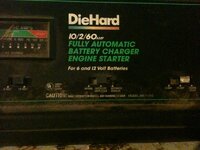H
Holly_squirrel
Guest
It's bubbling but only slightly.

Ok I'm so green to this I'm lime neon green, so bare with me! 1. The black clamp goes on the relic , right? 2. Why is the scrap iron bubbling more than the relic? 3. Am I using the right charger n settings.4. I get more bubbling if I put charger on start engine, but I'm afraid it will burn out the charger. 5. There is a Slight , very slight, white vapor coming from tbe relic sometimes ... Is it harmful? And 6 th and most important ... What would happen if one of my cats or worse one of my kids happen to put their hand in the water while its on?
Sorry for simpleton questions, but you got to start somewhere ... And one last thing... Am I imagining it or could whatever is coming off the iron and I to tbe air be making my nostrils burn?

Ok I'm so green to this I'm lime neon green, so bare with me! 1. The black clamp goes on the relic , right? 2. Why is the scrap iron bubbling more than the relic? 3. Am I using the right charger n settings.4. I get more bubbling if I put charger on start engine, but I'm afraid it will burn out the charger. 5. There is a Slight , very slight, white vapor coming from tbe relic sometimes ... Is it harmful? And 6 th and most important ... What would happen if one of my cats or worse one of my kids happen to put their hand in the water while its on?
Sorry for simpleton questions, but you got to start somewhere ... And one last thing... Am I imagining it or could whatever is coming off the iron and I to tbe air be making my nostrils burn?
Upvote
0








